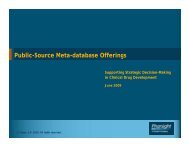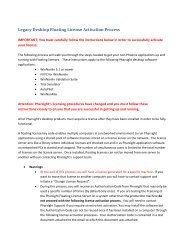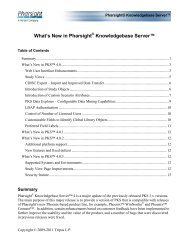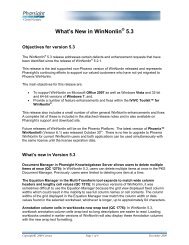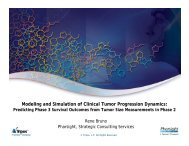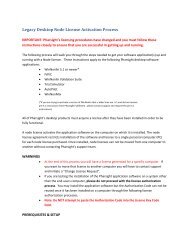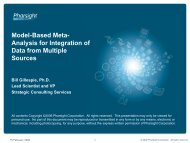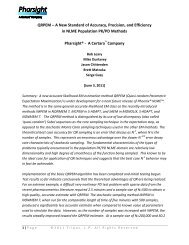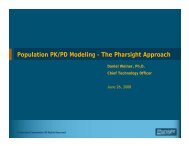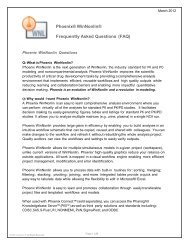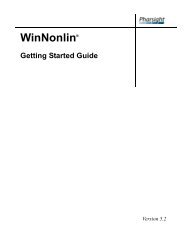Communicating the Value of Pharmacodynamic Modelling in Drug ...
Communicating the Value of Pharmacodynamic Modelling in Drug ...
Communicating the Value of Pharmacodynamic Modelling in Drug ...
Create successful ePaper yourself
Turn your PDF publications into a flip-book with our unique Google optimized e-Paper software.
Our purpose is to view and query model-based attributes based on<br />
simulation <strong>of</strong> mean responses.<br />
We can achieve detailed exploration <strong>of</strong> <strong>the</strong> dose-response curve for many<br />
comb<strong>in</strong>ations <strong>of</strong> endpo<strong>in</strong>ts, treatments, covariates, and compet<strong>in</strong>g products<br />
%Change from Basel<strong>in</strong>e <strong>of</strong> <strong>Drug</strong> B<br />
Response Selection<br />
Covariates, Assumptions<br />
Plots Display Trends<br />
Shaded area shows prediction<br />
<strong>in</strong>terval for expected doseresponse<br />
or response as a<br />
function <strong>of</strong> o<strong>the</strong>r explanatory<br />
variables (e.g., dose, time)<br />
Controllable Inputs<br />
(Treatments, Compet<strong>in</strong>g<br />
Therapies & Doses)<br />
Tables Display Details<br />
Dotted horizontal l<strong>in</strong>e(s) show<br />
def<strong>in</strong>ed success ranges, or “cut<br />
po<strong>in</strong>ts” based on product<br />
pr<strong>of</strong>iles<br />
Vertical l<strong>in</strong>es show explanatory<br />
variables <strong>of</strong> <strong>in</strong>terest (e.g., dose,<br />
time)<br />
Output Controls<br />
Tables display quantitative<br />
estimates <strong>of</strong> prediction <strong>in</strong>tervals<br />
or o<strong>the</strong>r <strong>in</strong>formation<br />
slide 35<br />
30 May 2008, ARCS<br />
© Pharsight Corporation All Rights Reserved



